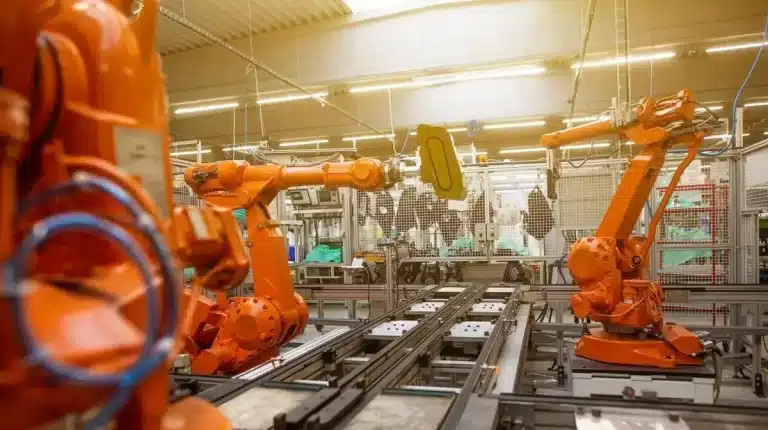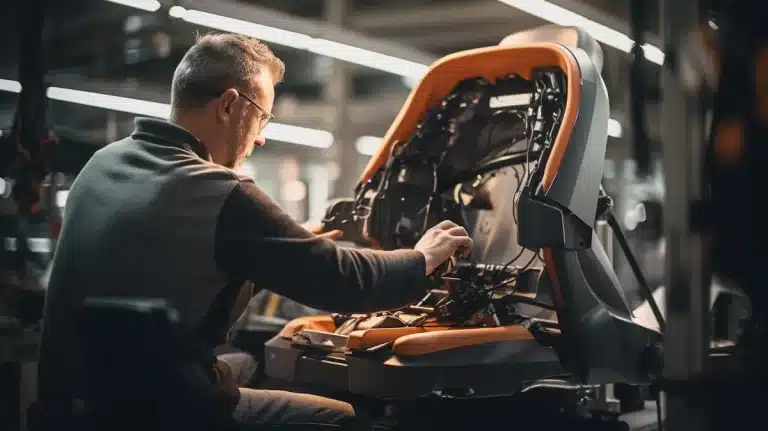Visual inspection plays a crucial role in the manufacturing industry. It involves the examination of products or components to detect defects or irregularities in the manufacturing process.
The accuracy and efficiency of visual inspection can greatly impact the quality control of products. However, visual inspection is traditionally a manual process, relying on human inspectors to identify and assess visual defects.
In recent years, the advent of Artificial Intelligence (AI) has revolutionized the field of visual inspection, offering automated solutions that enhance the inspection capabilities and improve overall manufacturing quality control.
What is visual inspection in the manufacturing industry?
Visual inspection, as the name suggests, is the process of visually inspecting products or components to detect any defects or irregularities.
It involves the use of the human visual system to identify visual imperfections and ensure visual quality in the manufacturing process.
Visual inspection is an essential part of quality control in the manufacturing industry, as it helps to ensure that products meet the required specifications and standards.
Importance of visual inspection in manufacturing
Visual inspection is of utmost importance in the manufacturing industry. It helps to identify and eliminate defective products before they reach the market, thereby reducing costs associated with product recalls and customer complaints.
Visual inspection also ensures that products meet the desired visual quality and are free from any cosmetic imperfections that could affect customer satisfaction. Moreover, it helps to maintain the brand reputation and build customer trust.
Common challenges in visual inspection
While visual inspection is crucial, it poses a few challenges. Human inspectors may overlook defects due to fatigue or human error.
Additionally, variations in human visual perception can lead to inconsistencies in inspection results. Furthermore, manual visual inspection can be time-consuming and expensive for large-scale manufacturing operations.
How does AI improve visual inspection?
The introduction of AI has revolutionized the field of visual inspection. AI-powered systems can automate the inspection process, offering numerous benefits over traditional manual inspection techniques. With AI, visual inspection becomes faster, more accurate, and cost-effective.
Introduction to AI in visual inspection
AI in visual inspection involves the use of computer vision and deep learning algorithms to analyze images or videos of products and detect defects or anomalies. These algorithms are trained using large datasets of labeled images, allowing them to learn and recognize various types of defects.
Benefits of using AI for visual inspection
Using AI for visual inspection brings several benefits.
Firstly, AI-powered systems can inspect products at a much faster rate compared to manual inspection. This leads to higher productivity and shorter manufacturing cycles.
Secondly, AI eliminates the subjectivity and variations associated with human visual inspections, ensuring consistent and reliable results.
Thirdly, automated visual inspection reduces the dependence on human inspectors and minimizes the risks of human error.
Furthermore, AI algorithms can detect defects that human inspectors may miss, resulting in higher accuracy and improved defect detection rates.
Examples of AI applications in visual inspection
AI is used in a variety of applications for visual inspection. One such example is the inspection of electronic components, where AI algorithms can detect surface defects, faulty connections, or missing components.
In the automotive industry, AI can be used to inspect paint quality, detect scratches or dents, ensure the proper assembly of components or for example detect seats wrinkles defects. AI can also be applied to food production, where it can identify contaminants, such as foreign objects or mold, in products.
What are the techniques used in visual inspection?
Visual inspection techniques can be broadly categorized into two types: manual and automated.
Manual visual inspection techniques
In manual visual inspection, human inspectors visually examine products or components to detect defects. This can involve the use of checklists or guidelines to ensure consistent inspection. However, as mentioned earlier, manual inspection is prone to human error and variations in visual perception.
Automated visual inspection techniques
Automated visual inspection relies on computer vision systems equipped with cameras and AI algorithms. These systems capture images or videos of products and analyze them to identify defects or irregularities. Automated visual inspection can significantly improve inspection speed, accuracy, and reliability.
Role of cameras in visual inspection
Cameras play a crucial role in visual inspection, both in manual and automated techniques. They capture images or videos of products, allowing inspectors or AI algorithms to analyze them for defects. High-resolution cameras with advanced capabilities are preferred for detailed inspection tasks.
How can visual inspection be standardized?
Standardization is essential in visual inspection to ensure consistent and reliable results.
Importance of standardization in visual inspection
Standardization provides clear guidelines and procedures for visual inspection, ensuring consistent inspection practices across different products or manufacturing lines. It helps to minimize variations in inspection results and enhances the overall quality control process.
Certification for visual inspectors
Certification programs can be implemented to train and certify visual inspectors. These programs ensure that inspectors have the necessary skills and knowledge to perform visual inspections accurately and reliably. Certification also helps to maintain the quality and credibility of visual inspection processes.
NDT techniques for visual inspection
Non-Destructive Testing (NDT) techniques, such as X-ray inspection or ultrasonic testing, can be used in conjunction with visual inspection to enhance defect detection capabilities. These techniques allow inspectors to identify internal defects, such as cracks or structural abnormalities, that may not be visible to the naked eye.
What are the future advancements in visual inspection?
The field of visual inspection is continually evolving, with several advancements on the horizon that have the potential to further improve inspection processes.
The role of drones in visual inspection
Drones are being increasingly utilized for visual inspection in various industries. They can access hard-to-reach or hazardous areas, providing a bird’s eye view for visual inspections. Drones equipped with high-resolution cameras and AI algorithms can monitor assets and detect defects or irregularities in real-time.
Remote visual inspection technologies
Remote visual inspection technologies allow inspectors to perform visual inspections from a remote location, eliminating the need for physical presence. These technologies make use of cameras and real-time video streaming, enabling inspections to be conducted efficiently and safely.
Improving quality control through AI in visual inspection
AI’s role in visual inspection is expected to expand further in the future. Advancements in deep learning algorithms and image processing techniques will enhance the capability of AI-powered inspection systems to detect even subtle defects or anomalies. AI will also contribute to real-time defect classification and analysis, enabling proactive quality control measures.
Frequently Asked Questions
What is visual inspection?
Visual inspection is the process of examining an object or system using the human eye to detect any defects, flaws, or abnormalities.
How can AI improve visual inspection?
AI can improve visual inspection by automating the process using machine learning algorithms and deep neural networks to analyze images and detect defects more accurately and efficiently.
What are the benefits of using AI for visual inspection?
Using AI for visual inspection has several benefits, including increased throughput, improved accuracy, reduced human error, cost savings, and the ability to inspect in remote or confined spaces where human inspection may be challenging.
What types of inspections can AI be used for?
AI can be used for various types of inspections, including quality control inspections, asset inspections, remote visual inspections, and regular inspections in manufacturing or production line environments.
How does AI improve the quality of inspections?
AI improves the quality of inspections by providing high-quality data and enabling automated inspection processes that are repeatable, consistent, and capable of detecting defects that may be difficult for human operators to identify.
Can AI perform visual inspections remotely?
Yes, AI can perform visual inspections remotely. By using drones or other remote devices equipped with cameras, AI algorithms can analyze images and videos captured in real-time without the need for an operator to be physically present.
What steps can be taken to implement AI for visual inspection?
To implement AI for visual inspection, you can start by identifying the specific inspection needs and challenges, selecting the right AI and machine learning tools, collecting and preparing high-quality training data, training the AI model, and integrating it into your existing inspection process.
What are the common methods used in AI-powered visual inspections?
Some common methods used in AI-powered visual inspections include deep neural networks, image recognition algorithms, predictive analytics, and quality management systems that ensure efficient inspection processes.
How can AI help in improving process monitoring?
AI can help in improving process monitoring by analyzing visual data in real-time and providing insights into process performance, identifying any deviations or abnormalities, and guiding operators to take corrective actions to maintain quality and uptime.
Is AI capable of identifying flaws or defects that are considered unacceptable?
Yes, AI is capable of identifying flaws or defects that are considered unacceptable. By training the AI model on a large dataset of acceptable and unacceptable samples, it can learn to differentiate between acceptable and unacceptable parameters, helping to maintain high-quality standards.
Final Words
So, if you’re wondering how to improve visual inspection with AI, look no further. By leveraging AI technologies, manufacturers can enhance accuracy, efficiency, and quality control.
Automated visual inspection powered by AI eliminates human error and ensures consistent and reliable results. As advancements like drones and remote inspection technologies emerge, the potential for further improvements in visual inspection with AI grows.
Embrace these cutting-edge solutions to unlock new levels of precision and revolutionize your inspection processes.
Want Flawless Product Quality?
Book a free strategy call to see how AI-powered inspection can streamline your production.

Gediminas Mickus
Business Development Manager


